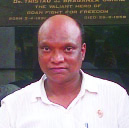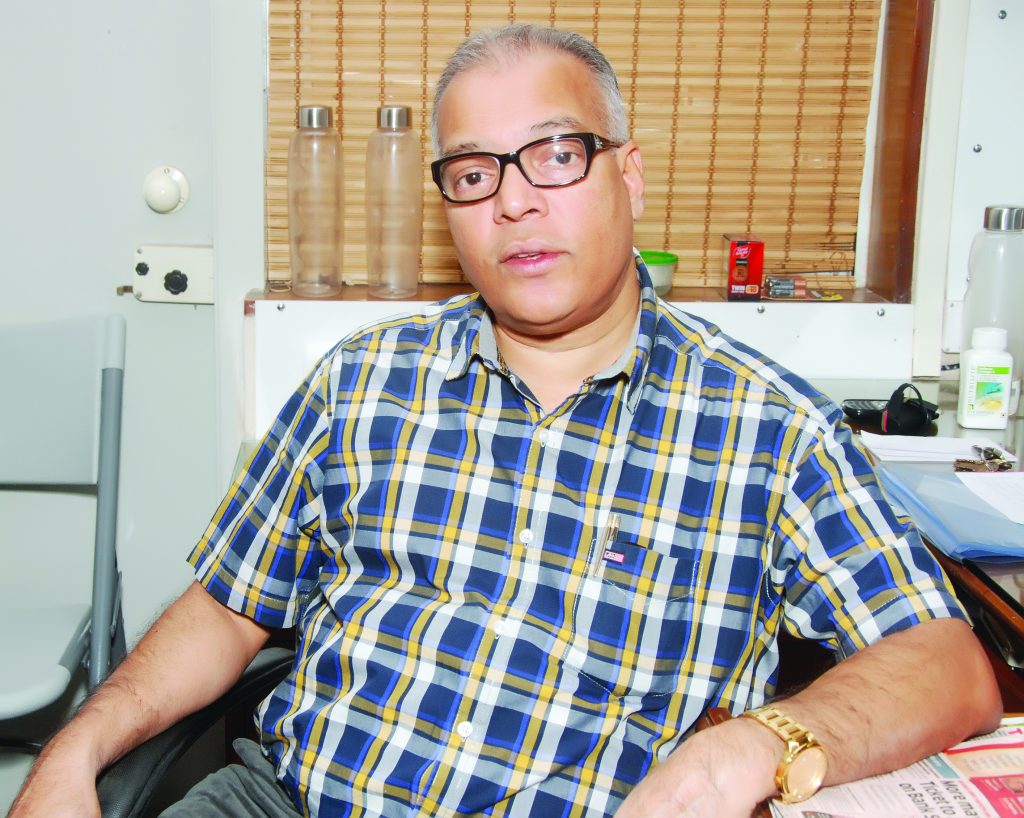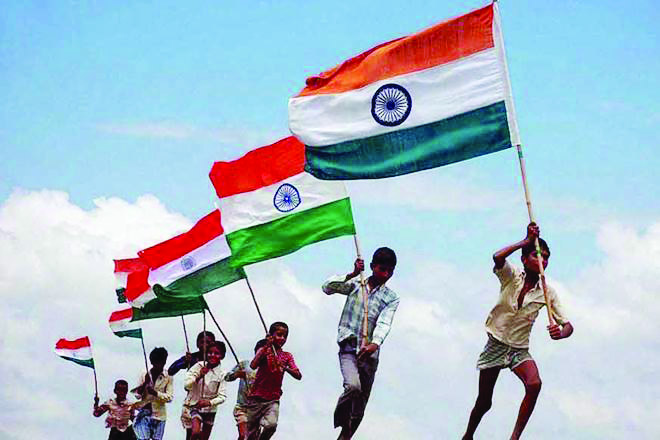By Nandita Haksar
AS a child Independence Day meant so much more than Republic Day. Perhaps it is because I associated Republic Day with parade and pageantry rather than the promulgation of the Indian Constitution. Independence Day was much more solemn.
The unfurling of the Indian flag atop Delhi Red Fort made for a scene which directly linked to the collective memory of August 15 which took place barely seven years before I was born.
I had always imagined that on August 15, 1947 the Union Jack was ceremoniously lowered and the tricolor flag of independent India flown atop Red Fort with Jawaharlal Nehru giving his famous tryst with destiny speech. It came as a sore disappointment when I learnt that the Union Jack was never lowered; and it was only on August 16 that Prime Minister Nehru unfurled the Indian flag at Red Fort.
In a way my understanding of the significance of Independence Day runs parallel with the various controversies over the Indian flag! But these controversies came later. Much later.
When I was seven years old I remember standing in awe looking at the gigantic tricolor flag fluttering on the flag post planted in the garden of our home in Lagos, the then capital of Nigeria. I would watch the guard lowering the flag slowly and solemnly as the evening turned to night.
The lowering of the flag reminded me of the time in my maternal grandparents home in Lucknow. Every evening I could hear a single bugle from the neighboring police line. Daya Nani, small framed and fragile, would lift me up and we stood on the verandah listening to the distant bugle. Daya Nani smelt of Ponds cream and the warmth of her embrace made me feel safe. She said the police were lowering the flag for the night and so it was time to go to sleep.
My mother had explained that the lowering of the flag meant that in the old days the parties to the battle would stop the war and rest. It was a time when the fighting would cease. And so beating of the retreat was a time we could feel safe and secure through the night.
I had never seen a flag flying in anybody’s home. It was my mother who told me that our home was the Indian embassy and Papa was the Indian High Commissioner; his job was to represent India.
The Indian flag was a symbol of India’s independence from British colonial rule. My mother said many people had been killed by the British just for trying to hoist the flag on top of government buildings.
What my parents never mentioned was that there had been so much discussion and debate on the colors and design of the flag. I had no idea that there was politics of colors; that the tricolor was not only a political symbol but also a cultural one.
AS I said I always liked the solemnity of the beating the retreat ceremony. It was associated with quiet nights, safety and security. But the ceremony as carried out on the India-Pakistan border near Amritsar gave me a totally another perspective.
A few kilometers from Amritsar at the Attari-Wagha border every evening there takes place a bizarre ceremony. As the sun sets, the iron gates at the border are opened and the ceremony begins with a blustering parade by the soldiers from both sides, and ends up in the perfectly coordinated lowering of the two nations’ flags.
The soldiers who carry out the ceremony are from Border Security Force in India and the Pakistan Rangers of Pakistan. There is nothing peaceful or serene about the 45-minute event in which the border looks like a battleground. The soldiers carrying out the lowering of the flags shout commands, there is aggressive heavy foot stomping and the soldiers lift up their legs very high as in goose marching.
The connection between nationalism and the threat of war is clearly made and cheered by onlookers on both sides of the border. Anyone who speaks of peace at that moment is likely to be lynched.
THE ceremony at the border also is a reminder that our independence came with a heavy cost of two million lives lost and 18 million displaced during the Partition.
The tricolor flag was designed to represent the unity between Hindus and Muslims; the green was supposed to be for Muslims and the saffron for Hindus. It was only later I realized that the 28 million Christians were not represented; although the white color band in the middle some say represents Christians and other religious communities.
The man who finally designed the Indian national flag, Pingali Venkayya (1876-1963), a freedom fighter from what is now Andhra Pradeh, was convinced of the centrality of religion in the life of India. In the first flag he chose yellow to represent Hindus, red for Muslims, orange for Buddhists, indigo for Christians, green for Sikhs, white for the Jains, rose for the Parsis and blue for the Jews.
Then in the 2000s the controversies began.
In September 2004 the Bangalore edition of a national newspaper carried a news item stating that the Gujarat BJP unit president Rajendra Singh Rana would be handing over the original national tricolor to Uma Bharti. According the news report, this was the flag first hoisted by the great freedom fighter Madam Cama (1861-1936) in Germany and handed to Rana’s forefathers who were freedom fighters.
Madam Cama and Shyamji Krishna Varma, did indeed design a national flag in which the top green stripe had eight blooming lotuses representing pre-independence India’s eight provinces; “Bande Mataram” was written across the central saffron stripe in Hindi. On the bottom red stripe, a half moon was on the right and the rising sun on the left, indicating the Hindu and Muslim faith.
On August 21, 1907, Madam Cama attended an International Socialist Conference being held at Stuttgart, Germany. Representatives from across the world had come to attend the conference. It was on this occasion that Bhikaji Rustom Cama unfurled her tricolor flag of green, saffron, and red stripes. The fiery revolutionary then announced,
“This is the flag of independent India. I appeal to all gentlemen to stand and salute the Flag.”
The same flag was later smuggled into India by socialist leader Indulal Yagnik and is now on display at the Maratha and Kesari Library in Pune.
There is no historical evidence at all to back BJP’s claim that Madam Cama had given the original flag to Rana or that her design influenced the design of the tricolor as it is today.
Historians who have researched on the origins of the Indian flag all agree that the idea of the tricolor as we know it was born in the mind of a Andhra Congressman, Pingali Venkayya of Masulipatnam. Between 1918 and 1921 Venkayya persistently raised the question of the need to have a national flag at every session of the Congress. Mahatma Gandhi liked the idea but not the way it was conceived; as he remarked, “in his [Venkayya’s] designs I saw nothing to stir the nations to its depths.”
Then a north Indian patriot, Lala Hansraj, suggested that any such flag should have, as its centerpiece, the charkha, or spinning wheel. This attracted Gandhi, who told Venkayya to incorporate the feature in his design.
Gandhi also expressed the wish that the national flag should be in three colors; red to represent Hindus, green to represent Muslims, and white to represent peace as well as all the other faiths of India.
Then a patriot from Punjab, Lala Hansraj, suggested that the flag should have, as its centerpiece, the charkha, or spinning wheel. This attracted Gandhi, who told Venkayya to incorporate the feature in his design.
In August 1931 a committee of the Congress decided to make certain changes in the design. Red was replaced by saffron, which would be placed first. The white band would come next, in between saffron and green, to heighten the effect and “show off the whole flag to advantage.” The spinning wheel was retained, but placed in the white strip alone.
Endorsing these changes, Gandhi observed that the “tricolor represents and reconciles all religions.”
At the time of Indian independence a committee of the Constituent Assembly decided that while they would retain the colors and spirit of the tricolor, they needed to make some changes, if only to ensure that the flag of independent India was not identified with the Congress party alone.
Finally, it was resolved that the spinning wheel would be replaced by an Ashoka Chakra.
I read an article by Layla Tyabji, the daughter of a diplomat and senior colleague of my father, that it was her parents who had first thought of replacing the charkha with the chakra. She wrote:
“Meanwhile, without thinking too much about it, everyone had assumed that the Congress tricolor flag designed by Pingali Venkayya, with Gandhiji’s charkha in the middle, would be the national flag. Our independence struggle had been fought under its banner. However, there was opposition to a party flag representing the nation. So, my parents were tasked with re-doing the flag, and they took the same Ashoka chakra and put it on the tricolour. Once it was done, it all seemed so natural and obvious. Originally, my mother had painted a black chakra, but Gandhiji objected so it became navy blue.”
She goes on to say: “My father watched that first flag – sewn under my mother’s supervision by Edde Tailors & Drapers in Connaught Place – go up over Raisina Hill.”
Apparently Gandhi was upset by more than the color of the chakra. When Mahatma Gandhi first heard of this he was dismayed. “The Congress has been national from its very inception,” he insisted. “But he was ultimately persuaded of the change. The colors remained the ones he had chosen, and with the meanings he had given them: unity, non-violence, and social harmony.
Shortly after Mahatma Gandhi’s assassination, there were widespread reports of RSS activists trampling upon the tricolor. This greatly upset the prime minister, Jawaharlal Nehru. In a speech on the 24th of February 1948, Nehru spoke sorrowfully of how “at some places members of the RSS dishonored the National Flag. They know well that by disgracing the flag they are proving themselves as traitors…”
Laila wrote her piece in the midst of the unseemly controversy over who raised the first flag, the meaning of the flag and who designed it. She just wanted to put the facts on record. But the media created further controversy by saying “Muslim woman designed the national flag.”
Laila Tyabji’s father lived in Shantiniketan, walking distance from my parents’ home. I had seen him riding a bike even when he was well into his eighties. His younger son, Khalid, would ride a cycle to Delhi University every day. I think Laila’s parents would have preferred to have been described just as Indians who had contributed to the making of the flag; just as Madam Cama and Venkayya would have; even if they knew religion was something that played an important role but they wanted to build a nation where religious differences did not matter; a place where we all equally thought of as home.
The feeling that the national flag aroused was expressed by a poet. Sarojini Naidu told the Constituent Assembly on what the Indian flag meant to her: “Remember under this flag there is no prince and there is no peasant, there is no rich and there is no poor. There is no privilege; there is only duty and risibility and sacrifice. Whether we be Hindus or Muslims, Christians, Jains, Sikhs or Zorostrians and others, our mother India has one undivided heart and one indivisible spirit. Men and women of reborn India rise and salute this Flag! I bid you, rise and salute the Flag.”
SAROJINI Naidu was talking of the promise of the tiranga. It is for us to work to realize it. It is a long painful journey for each of us and for the nation and Independence Day is an important milestone which we should remember.
(Nandita Haksar is a human rights lawyer, teacher, campaigner, writer and keen observer of changing times!)
WHAT DOES AUGUST 15 MEAN TO YOU?
Goan Observer asked around and some answers were as interesting as thought-provoking!
Are we fulfilling our freedom fighters dreams?

What freedom means to me

